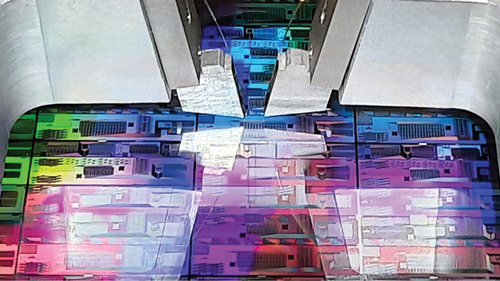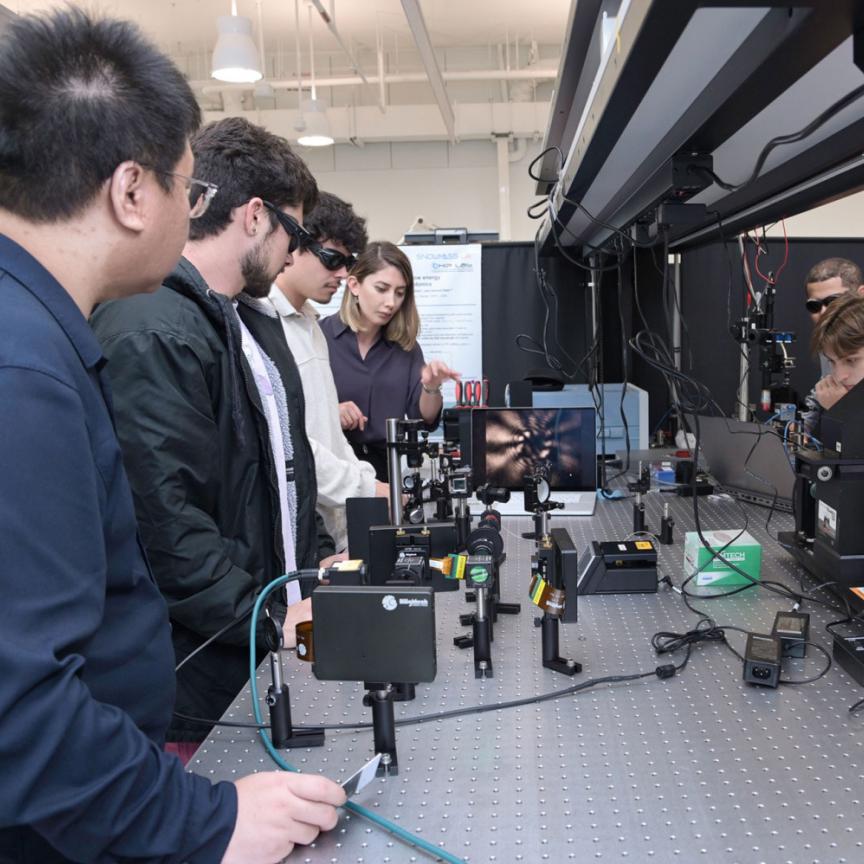A look at the market for photonic integrated circuits and some of the products and solutions available. This article was last updated in 2023.
A photonic integrated circuit (PIC) is a device that can integrate multiple photonic components such as interconnect waveguides and optical amplifiers, to form one photonic circuit.
PICs are similar to electronic integrated circuits, with the main difference being that PICs can perform functions for information signals imposed on optical wavelengths typically in the visible spectrum or near infrared 850 to 1,650nm
Like electronic integrated circuits, they are fabricated in foundries using photolithography to pattern wafers for etching and material deposition. PICs are used in a wide range of applications, thanks to their small size and robust nature. These include: high-speed data transmission for the telecoms and datacoms sectors; optical sensing for the environment, medicine and life sciences; various imaging and scanning systems for civil security and industry; and lidar systems in the automotive sector.
The first transmitter PIC was the electroabsorption-modulated laser (EML), which was developed in 1987. Today, this cost-effective photonic hardware is also seeing high demand in applications such as data centres, according to the latest data from research firm, ResearchAndMarkets.com
The company said that the global PIC market was valued at $5,790m in 2020, and predicted that it will be worth $21,649m by 2026, registering a compound annual growth rate of 22.4 per cent during the forecast period of 2021 to 2026.
Photonic integrated circuit products on the market now
Vendors that produce PICs include Ams, which acts as a foundry partner, offering semiconductor manufacturing capabilities. A number of industry process technologies are used such as 0.18µm and 0.35µm digital and mixed signal CMOS, high-voltage CMOS and BICMOS processes. The company’s ‘More than Silicon’ initiative meant that it moved from electronic to photonic integrated circuits, using a silicon nitride process. The foundry now also offers optical waveguides and functional building blocks in a PIC library
Applied Nanotools is an integrated photonics foundry that specialises in rapid turnaround prototyping and low-to-mid volume production. The company uses electron beam lithography to achieve feature sizes of 60nm. An online design submission system is available, alongside a process design kit for the fabrication service.
Bright Photonics is an independent design house for PICs in silicon, III-V, SiN, silica and polymers. The company supports businesses and research establishments in PIC development from application ideas to prototypes and design for volume production. Bright also commercially supports the PIC design platform ‘Nazca-Design’ for lowering barriers to photonic technologies. Applications include sensing, data and telecoms, microwave photonics, bio-photonics and quantum technology.
Eospace manufactures high-performance electro-optic integrated circuits and components for the designers and builders of next-generation optical telecommunication and photonic systems. Products use proprietary lithium niobate integrated optics devices to produce exceptionally low insertion loss and broad bandwidth devices.
Freedom Photonics is a manufacturer of photonic components, modules and subsystems. Its photonic integration platforms and semiconductor laser and photodetector technologies allow its products to be used in applications such as optical sensing, high-performance optical interconnects and fibre optic communications applications. Core photonic technology is available in indium phosphide, gallium arsenide and silicon.
iC-Haus develops and manufactures application-specific integrated circuits (ASICs) and has expertise in monolithic mixed-signal circuits and microsystems. It has in-house wafer backend, chip assembly and test facilities, as well as global subcontracted wafer foundry and assembly partners. Assembly is performed in standard plastic packages and, for the Opto and power ICs, in the chip-on-board/flex and flip-chip technique. Packaging can be customised, for example with multi-chip-modules; furthermore, the chip layout and circuit topology is tailored to customer’s individual requirements.
Infinera introduced the first large-scale PIC in 2005 and today offers the sixth-generation PIC in ICE6. Leveraging high-performance indium phosphide, Infinera’s PICs integrate a wide range of optical functions on a single chip. This reduces cost, footprint, and power consumption while improving performance and reliability. In addition, Infinera has invested heavily to build its own indium phosphide PIC fabrication facility.
LioniX International offers PIC modules based on silicon nitride waveguides. Customised solutions are available for OEMs and system integrators, from design to fully assembled modules. PIC enabled modules are based on the company’s proprietary waveguide technology (TriPleX).
Interconnect is Lumerical’s PIC simulator. It verifies multimode, bidirectional, and multi-channel PICs. Creating a project in the hierarchical schematic editor provides an extensive library of primitive elements, as well as foundry-specific PDK elements, to perform analysis in the time or frequency domain.
Ligentec manufactures PICs for customers in high-tech areas such as communication for ground and space applications, quantum technologies, lidar, and biosensors. The company leverages all-nitride-core technology, and offers a foundry service for its fabrication technologies in silicon nitride, which is operated by the firm’s process engineers.
Partow Technologies develops photonics and electronic technologies for communication and sensing applications, such as advanced photonic and electronic substrates and components. Its core technology is ultra-high vacuum surface activated bonding capability, which allows a variety of materials to be bonded at room temperature. The company provides a bonding service, and custom thin film and thick film fabrication services. It is developing advanced photonic components based on thin film lithium niobate and lithium tantalate bonded substrates.
Phix Photonics Assembly offers assembly services and contract manufacturing for photonic integrated circuits and MEMS. The company builds optoelectronic modules based on major PIC technology platforms, such as indium phosphide, silicon photonics, silicon nitride, and planar lightwave circuit. It specialises in chip-to-chip hybrid integration, coupling to fibre arrays, and interfacing of DC and RF electrical signals.
Sondrel is a provider of high-quality, complex system-on-chip designs across a number of markets, offering a turnkey ASIC service from system to silicon supply. Its designs have appeared in a variety of products including mobile phones, cameras, security systems, AR/VR systems and many more.
Synopsys is accelerating the adoption of photonic IC technologies with a unified solution, which includes the OptoCompiler electro-optical IC design solution, the OptSim simulation solution, and Photonic Device Compiler for photonic device design and PDK development. Synopsys Photonic Solutions offer a unified design platform to help IC designers and photonic engineers innovate consumer, health and industrial applications.
VLC Photonics operates using the fabless business model to offer independent pure-play services, and collaborate with a global network of foundries, packagers and providers. The company can assess the feasibility of integrating any optical system into a photonic chip, and provide cost estimates, expected performances and foreseeable limitations. The whole integration process is covered, from the photonic modelling, simulation, design and layout, to the prototyping, packaging, die and wafer level testing or certification if needed. Stand-alone outsourced design services, foundry process design kit development, and fab reports can be provided.
VPIphotonics integrates simulation techniques and professional design functions for integrated photonic devices, components, optical transmission system and network applications. Designed PICs cover applications such as coherent transmitters and receivers for advanced modulation formats, optical interconnects, recirculating optical buffers and reconfigurable delay lines, multi-ring filters and arrayed waveguide gratings, and other monolithically integrated or hybrid PICs based on silicon, indium phosphide or gallium arsenide substrates.
This is not an exhaustive list. If you provide photonic integrated circuits and related products and solutions, and would like your company to be included, please let us know at editor.electro@europascience.com.

VLC Photonics: Featured photonic integrated circuits product

VLC Photonics offers worldwide independent testing services for both vertical and edge emitting photonic integrated circuits (PICs) at wafer level. Photonic integration is gaining momentum and more people are looking at developing PICs for many applications, including optical transceivers, LiDAR, quantum and sensing among others.
As PICs are not as mature as electronic circuits, it is still critical to do extensive characterisation and testing for validating PIC designs towards production. To this aim, wafer level testing is strongly needed, and needs to be compatible to both vertical and edge emitting types of PICs.
With the new VLC Photonics Wafer level testing services, companies can close design loop from fabricated to measured devices with massive data, allowing for statistical parameter modelling. Moreover, these massive data provide feedback for fab yield improvement, to accelerate product development and volume ramp up, as well as automate the identification of known good dies (KGDs) to sort dies wafers in production, and towards packaging. Find out more about wafer level testing services on the VLC Photonics website.

